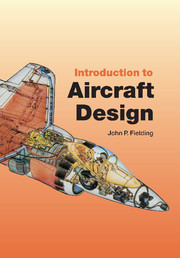Book contents
- Frontmatter
- Contents
- Preface
- Acknowledgements
- 1 Introduction
- 2 Why should we design a new aircraft?
- 3 Why is it that shape? – Civil aircraft
- 4 Why is it that shape? – Other types
- 5 What's under the skin? – Structure and propulsion
- 6 What's under the skin? – Airframe systems
- 7 What's under the skin? – Avionics, flight control and weapon systems
- 8 Why do aircraft cost so much?
- 9 What help can I get? – Bibliography and computer-aided design
- 10 The shape of things to come – Should the project continue?
- 11 What can go wrong? – Some lessons from past aircraft projects, and a glimpse into the future
- Appendix A Useful aircraft design data
- Appendix B A–90 parametric study. Example – the A-90 500-seat airliner
- Appendix C The prediction of aircraft reliability and maintainability targets
- References
- Index
9 - What help can I get? – Bibliography and computer-aided design
- Frontmatter
- Contents
- Preface
- Acknowledgements
- 1 Introduction
- 2 Why should we design a new aircraft?
- 3 Why is it that shape? – Civil aircraft
- 4 Why is it that shape? – Other types
- 5 What's under the skin? – Structure and propulsion
- 6 What's under the skin? – Airframe systems
- 7 What's under the skin? – Avionics, flight control and weapon systems
- 8 Why do aircraft cost so much?
- 9 What help can I get? – Bibliography and computer-aided design
- 10 The shape of things to come – Should the project continue?
- 11 What can go wrong? – Some lessons from past aircraft projects, and a glimpse into the future
- Appendix A Useful aircraft design data
- Appendix B A–90 parametric study. Example – the A-90 500-seat airliner
- Appendix C The prediction of aircraft reliability and maintainability targets
- References
- Index
Summary
The previous chapters have shown the complexity of aircraft, and their constituent parts. Their design is a daunting, but potentially satisfying task. Designers need all the help which they can get to achieve successful results.
The usual starting point is a sound aeronautical education. Design is learnt by a combination of theoretical education and design experience at University and/or in Industry. It must be stressed that design is much more than analysis. It is a creative process involving the synthesis of knowledge from many disciplines, monitored by qualitative and quantitative checks. These should assess the value of the necessary design compromises and lead to optimum designs. Advice from, and work alongside, experienced designers is an invaluable part of the education process. People learn how to design by actually doing it! Less experienced design organizations can be helped by specialist consultants. Such help is, however, not always available, but much design knowledge and experience has been encapsulated in the publications and programs described later in this chapter.
Many individuals and organizations publish reports, papers and memoranda, many of which contain relevant data. Modern libraries use on-line computerized data bases which sort and codify these date sources on the basis of key-words. A description of such reports is beyond the scope of this book. The most exciting new development has been the advent of the internet.
- Type
- Chapter
- Information
- Introduction to Aircraft Design , pp. 129 - 148Publisher: Cambridge University PressPrint publication year: 1999



